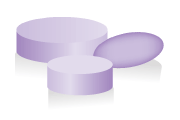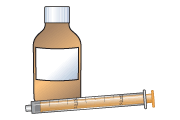Chlorambucil for nephrotic syndrome
This leaflet is for parents and carers about how to use this medicine in children. Our information may differ from that provided by the manufacturers, because their information usually relates to adults. Read this leaflet carefully. Keep it somewhere safe so that you can read it again.
Name of medicine
Chlorambucil
Common brands: Leukeran
Why is it important for my child to take Chlorambucil?
Your doctor may recommend this treatment if your child’s nephrotic syndrome keeps coming back. Usually, chlorambucil is taken for 8 weeks. It is taken at the same time as and in addition to the steroid treatment and should increase the time that the nephrotic syndrome stays in remission (i.e. doesn’t come back).
What is Chlorambucil available as?
- Tablets: 2 mg
- Liquid medicine can be ordered specially from your pharmacist
When should I give Chlorambucil
Chlorambucil is usually given once each day. This is usually in the morning.
Give the medicine at about the same time(s) each day so that this becomes part of your child’s daily routine, which will help you to remember.
How much should I give?
Your doctor will work out the amount of Chlorambucil (the dose) that is right for your child. The dose will be shown on the medicine label.
It is important that you follow your doctor’s instructions about how much to give.
How should I give Chlorambucil?

Tablets
- Tablets should be swallowed with a glass of water, squash or juice. Your child should not chew the tablet.

Liquid medicine
- Shake the medicine well.
- Measure out the right amount using an oral syringe or a medicine spoon. You can get these from your pharmacist. Do not use a kitchen teaspoon as it will not give the right amount.
When should the medicine start working?
The medicine will start working straight away, although this may not be obvious. The aim of treatment with chlorambucil is to increase the time that your child’s nephrotic syndrome stays in remission, so it will take some time to know if it has helped.
What if my child is sick (vomits)?
- If your child is sick less than 30 minutes after having a dose of Chlorambucil, give them the same dose again.
- If your child is sick more than 30 minutes after having a dose of Chlorambucil, do not give them another dose. Wait until the next normal dose.
If your child is sick again, seek advice from your family doctor, nurse, pharmacist, or hospital. They will decide what to do based on your child’s condition and the specific medicine involved.
What if I forget to give it?
Give the missed dose when you remember during the day, as long as this is at least 12 hours before the next dose of Chlorambucil is due.
Never give a double dose of Chlorambucil.
What if I give too much?
If you think you may have given your child too much Chlorambucil, contact your doctor or local NHS services (details at end of leaflet) or take your child to hospital. Have the medicine container or packaging with you, even if it is empty. This will be useful to the doctor.
It may be dangerous to give too much Chlorambucil.
Are there any possible side effects?
We use medicines to make our children better, but sometimes they have other effects that we don’t want (side effects).
Side effects you must do something about
Contact your doctor straight away if your child has a fever (temperature above 38°C) with a sore throat or cough, or if they have unusual bleeding that is difficult to stop, or severe bruising.
If your child gets a yellowish tinge to the skin or whites of the eyes, contact your doctor straight away, as there may be a problem with your child’s liver.
If your child has pain when they urinate (do a wee) or have any difficulty urinating, contact your doctor.
Other side-effects you need to know about
When your child first starts taking chlorambucil they may feel sick (nausea) or be sick (vomit) and they may get diarrhoea. It may help for your child to take the medicine with some food or a small glass of milk. These effects should wear off as your child gets used to the medicine. If they are still a problem after 2 weeks, contact your doctor.
- Chlorambucil may affect your child’s blood.
- They may bruise more easily and they may get tiny bruises or spots on their arms or legs.
- They may get nose bleeds, their gums may bleed when they brush their teeth, and it make take longer than usual for bleeding to stop.
- They are more likely to get infections, and they may take longer than usual to fight these off. They may also become ill very quickly, in which case you should contact your doctor.
- Your child may get swollen feet or ankles, sores in the mouth or on the lips, or a rash that spreads over the body or mouth, but these are rare.
- Girls may find their periods become irregular or stop, but they will return to normal after stopping the treatment.
Your child’s stools (poo) may seem black and tar-like, but this is rare.
There may sometimes be other side effects that are not listed above. If you notice anything unusual and are concerned, contact your doctor. You can report any suspected side effects to a UK safety scheme at mhra.gov.uk/yellowcard
Can other medicines be given at the same time as Chlorambucil?
- You can give your child medicines that contain paracetamol or ibuprofen, unless your doctor has told you not to.
- Chlorambucil should not be taken with some medicines. Tell your doctor or pharmacist about any other medicines your child is taking before giving Chlorambucil.
Check with your doctor or pharmacist before giving any other medicines to your child. This includes herbal and complementary medicines.
Is there anything else I need to know about this medicine?
If your child comes into contact with anyone who has measles, chickenpox or shingles, contact your doctor straight away, as they may need special preventative treatment.
- Your doctor will test your child’s blood regularly to check that chlorambucil has not affected their liver, kidneys or blood.
- Chlorambucil is also used for chemotherapy in cancer, but at a higher dose and for a longer time. You may have heard about some serious side-effects associated with chemotherapy. These are very rare when used for nephrotic syndrome. Talk to your doctor if you are worried.
- Chlorambucil may, rarely, cause infertility in males and females who have reached puberty, but this is very unlikely as it is only used for a short period in nephrotic syndrome.
- If your child takes chlorambucil for a long time, there is a low risk of some forms of blood cancer. Your doctor will discuss this with you before starting the medicine and will do regular blood tests to check for these effects. However, the benefit of taking the medicine is greater than the risk of cancer.
- Chlorambucil may harm an unborn baby. If your daughter is sexually active, it is very important that she uses adequate contraception to prevent unplanned pregnancy and continues it for at least 1 month after stopping treatment. The oral contraceptive pill can be used safely in woman or girls taking chlorambucil. If your daughter thinks that she may be pregnant, it is important that she sees your family doctor as early as possible. She should keep taking her medicine until she sees her doctor.
General advice about medicines
- Try to give medicines at about the same times each day, to help you remember.
- Only give this medicine to your child. Never give it to anyone else, even if their condition appears to be the same, as this could do harm.
- Make sure that you always have enough medicine. Order a new prescription at least 2 weeks before you will run out.
- Make sure that the medicines you have at home have not reached the ‘use by’ date on the packaging. Give old medicines to your pharmacist to dispose of.
- If you are not sure a medicine is working, contact your doctor but continue to give the medicine as usual in the meantime. Do not give extra doses, as you may do harm.
If you think someone else may have taken the medicine by accident, contact your doctor straight away.
Where should I keep this medicine?
- Keep the medicine in a fridge and protect it from light. Make sure that it does not freeze.
- Make sure that children cannot see or reach the medicine.
- Keep the medicine in the container it came in.
Who to contact for more information?
Your doctor, pharmacist or nurse will be able to give you more information about Chlorambucil and about other medicines used to treat nephrotic syndrome.
England: NHS 111
Tel 111
www.nhs.ukScotland: NHS 24
Tel 111
www.nhs24.scotNorthern Ireland: NI Direct
Wales: NHS 111 Wales
Tel 111
www.111.wales.nhs.ukKidney Care UK
01420 541424
www.kidneycareuk.org/National Kidney Federation
0800 169 0936
www.kidney.org.uk/Copyright disclaimer
Version [2]. © NPPG, RCPCH and WellChild, all rights reserved. Review by May 2015.
The primary source for the information in this leaflet is the British National Formulary for Children. For details on any other sources used for this leaflet, please contact us through our website, www.medicinesforchildren.org.uk.
We take great care to make sure that the information in this leaflet is correct and up-to-date. However, medicines can be used in different ways for different patients. It is important that you ask the advice of your doctor or pharmacist if you are not sure about something. This leaflet is about the use of these medicines in the UK, and may not apply to other countries. The Royal College of Paediatrics and Child Health (RCPCH), the Neonatal and Paediatric Pharmacists Group (NPPG), WellChild and the contributors and editors cannot be held responsible for the accuracy of information, omissions of information, or any actions that may be taken as a consequence of reading this leaflet.
